Saltwater Chronicles - part 19
| Sysadmin Note |
|---|
| Part 18 can be found here |
Saltwater Gamefish of the Sebastian Area
In this installment we will be covering the Longnose Gar, Barracuda and the Look Down. These are not the normal fish species that are covered in most fishing magazines however they can be caught by the saltwater fly angler and each has its own appeal.
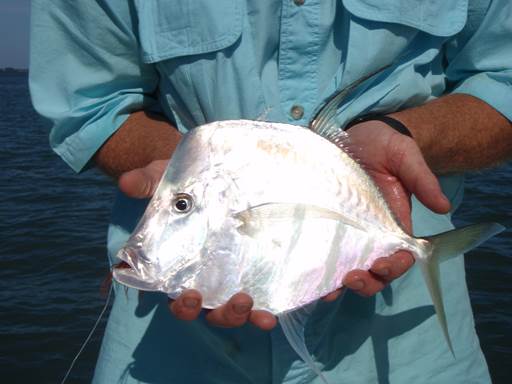
Look Down [Selene vomer], now these are different looking fish and I remember the first time I caught one, after it was photographed and released I grabbed for the fish identification book to figure out what I had just caught. It was a beautiful silvery fish with a pearly hue and I couldn't wait to catch another, later when I telling a friend about them he asked if I had kept any of them to eat. I replied that I had release them and he told me about how good they were as table fare.
The Look Down and the Atlantic Moonfish [Selene setapinnis] are often confused by the angler as they are very similar in size and shape and are often found together. They can be found anywhere in the shallow coastal waters and are often found around bridge, dock pilings and prefer sandy bottoms. They will also gather around navigational markers and lighted docks where they will gather a night around the lights. They also are found in brackish water and are found near offshore up to depths of 180 feet. The average size is one to two pounds but can reach four pounds plus and they live for twenty years, they are spirited fighter and are very aggressive furthermore they are an excellent panfish to eat.
The feed on small crabs, shrimp, worms and various minnows and a number of different patterns are effective.
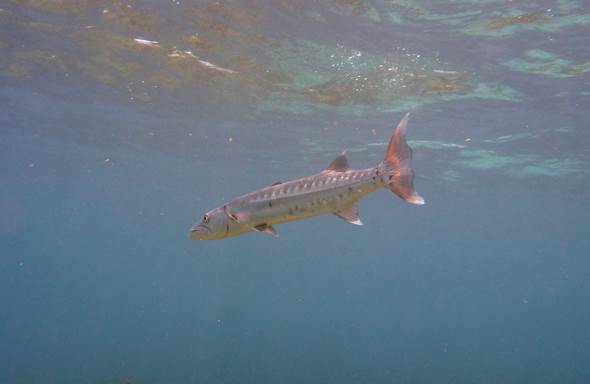
Great Barracuda
Great Barracuda [Sphyraena barracuda] are also called Cuda, Sea Pike and Sea Tiger are found in a variety of waters from the shallows of the lagoons and estuaries to the near shore surf and the open ocean and have a wide range of water temperature tolerance. The juveniles can be found in brackish water but the adults prefer saltwater environments. The can reach five and half feet in length and can attain weights of one hundred ten pounds and they live up to fourteen years.
Smaller Cuda are often found around the mangroves, bridges, and grass flats and around the channel markers. In the shallow coastal waters the anglers normally catch Cuda ranging from two to ten pounds. Did you know that the small Cuda are excellent table fare and little is known of their spawning habits.
Barracuda are fast predators which feed on a wide variety of fish and they locate their prey by sight and move in for the kill with tremendous speed (as fast as 36 mph) and are daylight feeders. They are great fighters and are very exciting to catch; they are in fact the saltwater version of the Northern Pike.
Be careful of consuming large Barracuda as they sometimes carry Ciguatera which is type of poison which can cause serious illness. Due to their mouth full of sharp teeth and aggressive nature be careful in handling and unhooking the Cuda.
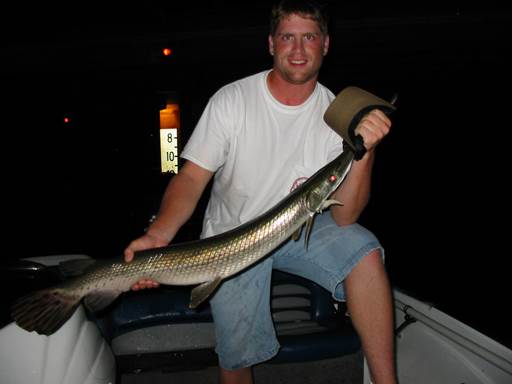
Longnose Gar:
Longnose Gar Lepisosteus osseus this species is found in many fresh water areas but also are found in the brackish water. I have caught Longnose Gar in the Choctawhatchee River and many other tidal rivers but the largest was taken in the Saint Sebastian River a few years ago on Christmas Eve and the Gar was almost forty pounds and put up an incredible fight.
The Longnose Gar is wide spread across the eastern half of the United States. The Saint Sebastian River has an excellent population of these and I have taken many of them over the years.
The average size is between five and fifteen pounds but can grow large as fifty plus pounds. The Gar is actually a good eating fish but few angler do so, also note that the roe poisonous and should not be consumed. Another interesting point of interest is that the Gar can actually breathe air a fact which is fairly unique among fish.
They prefer lazy rivers along with reservoirs, bayous and estuaries and prefers sluggish backwaters and are often seen floating near the surface. They migrate to spawn in clear clean water and can live up to twenty two years. The young will feed on insects and small minnows however within a short time they switch to a complete fish diet. Depending on the area the diet will consist of shad, small catfish, menhaden or mullet.
They are ambush predators laying wait or slowly stalking their prey. They will feed both day and night and are more active a night. This species seldom attracts much attention from fly anglers; but believe me they are a very exciting and challenging fish to catch. Oh be careful of their needle sharp teeth, I generally wrap a towel around the long nose when handling them.
Now I have caught Longnose Gar on standard saltwater patterns however I have often hooked and lost many Gars because the fly got hook on the nose and failed to penetrate. Therefore I have pattern type that I use when I am targeting Longnose Gar.
I will also include my favorite Barracuda pattern along with a pattern for Look Down's and Moonfish. Many of the Clouser style minnows and Bullet Baitfish patterns will work on Look Down's and Moonfish as will small Shrimp or Grub patterns. However these also feed on Marine Worms.
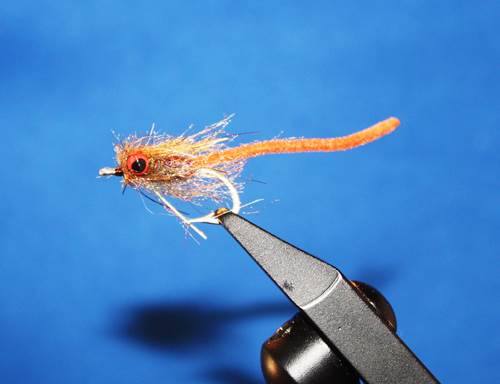
Brown Marine Worm
- Hook: Mustad 3407 Sizes: 4-8
- Thread: Brown 6/0
- Bead or Eyes: Optional, Copper metal is the best.
However I tie this pattern in several different colors and I match the bead color to the body color. I also tie this pattern using very small dumb-bell eyes which are painted Red with black centers and they are tied on the top of the hook shank so the pattern will turn over or invert in the water with the hook riding point up. - Weedguard: 20 pound monofilament
- Tail: Brown Ultra Chenille, melt the tip to improve durability
- Body: Ice UV Dub Brown, spun in a dubbing loop
- Collar: Root Beer Dubbing brush, two wraps to enhance the illusion of life and because it makes the imitation look cute!
Standard patterns like Surf Candies, Tarpon Toad Streamer and many other work on Longnose Gar however because their long bony noses and abundant teeth the fly hook often doesn't find a good bite and pull out. However due to their feeding habit of slashing with their long toothy nose you can tie flies using combed out strands from nylon rope. When they slash at the imitation their teeth get tangled in the rope and I have often landed them without sinking a hook into flesh! The following is one of my favorite patterns styles shown in a couple of color variations.
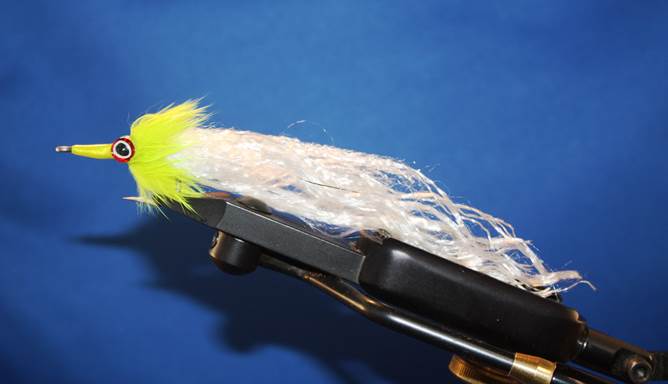
Gar Nylon Rope Streamer (Chartreuse & White)
- Hook: Tiemco 800S Sizes: 4/0-2
- Thread: A Nylon Chartreuse
- Wing/Body: White Ultra Hair fibers, with eight to twelve strands of Silver Flash-A-Bou with another small bunch of White Ultra Hair fibers on top, the creates a good base for the imitation, then surround the Ultra Hair with White Nylon Rope fibers. The over-all length of the imitation should be from six to nine inches.
- Collar: Chartreuse strip of Rabbit fur wrapped
- Eyes: 3D Red with Black Centers applied with epoxy and eyes are set at the base of the collar and the nose is also coated.
Coloring of the imitation is the angler's choice but I like to add gill slashes and light barring or spots using a Sharpie Marker. The patterns can be tied in many different color combinations as the angler desires. Some have told me that you can tie them with a hook and that the rabbit and flash are not necessary however I like adding the frills, it makes me happy!
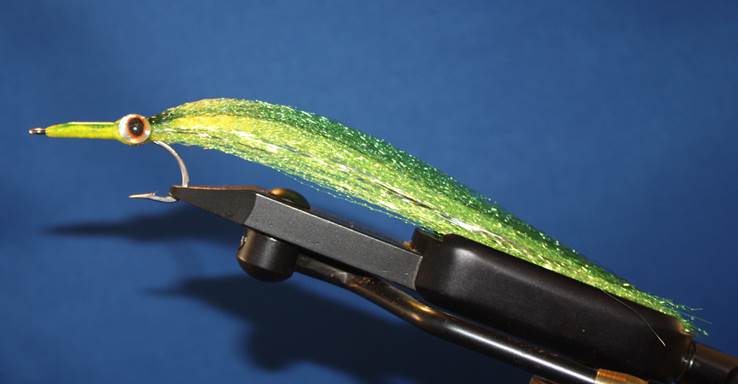
Chartreuse Cuda Candy - (Pattern Style developed by Bob Popovics)
The over length of the pattern can vary between six and nine inches in length.
- Hook: Mustad 34007 Sizes: 5/0 to 1/0
- Thread: Ultra Clear Mono
- Wing: Small bunch of Chartreuse Ultra Hair, with eight to fourteen fibers of Silver Flash-A-Bou, followed by Chartreuse Ultra Hair and a few strands of Black Ultra Hair fibers and topped with Green Ultra Hair.
- Eyes: 3D Orange with black centers, applied with epoxy and the entire head is coated as well.
This style of pattern is my favorite for Cuda and I seldom use others though I sure that there are many other effective patterns out there. Enjoy & Good Fishin'
| Sysadmin Note |
|---|
| Part 20 can be found here |
